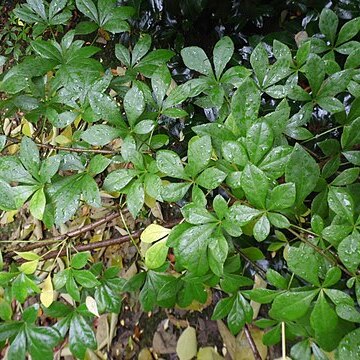Shrubs, to 3 m tall, sometimes climbers. Branches slender, forming both long and short shoots, slightly pendulous, glabrous, with few, scattered, reflexed, short prickles at nodes, rarely unarmed. Petiole 3-8 cm, glabrous, with small scattered prickles; petiolules very short; leaflets (3-)5, obovate or oblanceolate, 3-8 × 1-3.5 cm, submembranous to papery, both surfaces glabrous or sparsely setulose, abaxially sometimes pubescent or with brown or ferruginous tufted hairs in axils of veins, secondary veins 4 or 5 pairs, subconspicuous, base cuneate, margin crenate-serrulate, apex acute or shortly acuminate. Inflorescence borne in axils of leaves on short shoots, a solitary umbel or sometimes 2 or 3 umbels together; peduncles 1-4 cm; pedicels 6-10 mm, slender, glabrous. Calyx subentire or with 5 minute teeth. Corolla yellowish green. Ovary 2(or 3)-carpellate; styles free nearly to base, ca. 2 mm, slender. Fruit black at maturity, subglobose, ca. 6 mm in diam.; styles persistent, reflexed, 2-3 mm. Fl. Apr-Jul, fr. Jun-Oct.
More
A shrub. It loses its leaves during the year. It grows 3 m high. It can be a climber. The branches are slender and can hang down. There are a few short prickles. The leaves have 5 leaflets that are broadly sword shaped and 3-8 cm long by 2-5 cm wide. The flowers are in groups in the axils of leaves on short shoots. The fruit are round and black and 6 mm across.

